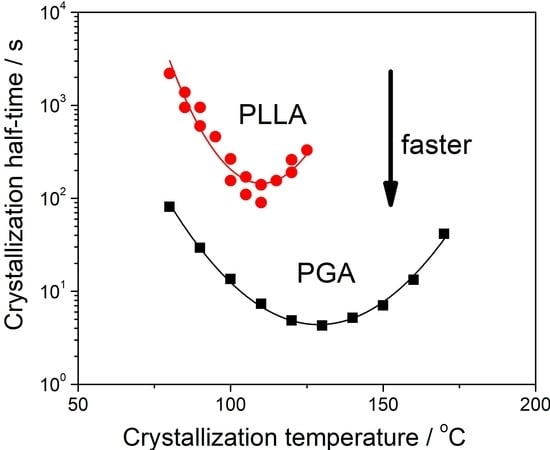Fast-Scanning Chip-Calorimetry Measurement of Crystallization Kinetics of Poly(Glycolic Acid)
Abstract
1. Introduction
2. Materials and Methods
2.1. Materials
2.2. Fast-Scanning Chip-Calorimetry Measurement
3. Results
3.1. Cooling Experiment
3.2. Heating Experiment
3.3. Isothermal Experiment
4. Discussion
5. Conclusions
Supplementary Materials
Author Contributions
Funding
Institutional Review Board Statement
Informed Consent Statement
Data Availability Statement
Acknowledgments
Conflicts of Interest
References
- Ashammakhi, N.; Rokkanen, P. Absorbable Polyglycolide Devices in Trauma and Bone Surgery. Biomaterials 1997, 18, 3–9. [Google Scholar] [CrossRef]
- Nair, L.S.; Laurencin, C.T. Biodegradable Polymers as Biomaterials. Prog. Polym. Sci. 2007, 32, 762–798. [Google Scholar] [CrossRef]
- Jem, K.J.; Tan, B. The Development and Challenges of Poly (lactic acid) and Poly (glycolic acid). Adv. Ind. Eng. Polym. Res. 2020, 3, 60–70. [Google Scholar] [CrossRef]
- Chatani, Y.; Suehiro, K.; Okita, Y.; Tadokoro, H.; Chujo, K. Structural Studies of Polyesters. I. Crystal Structure of Polyglycolide. Die. Makromol. Chem. 1968, 113, 215–229. [Google Scholar] [CrossRef]
- Montes de Oca, H.; Ward, I.M.; Klein, P.G.; Ries, M.E.; Rose, J.; Farrar, D. Solid State Nuclear Magnetic Resonance Study of Highly Oriented Poly (glycolic acid). Polymer. 2004, 45, 7261–7272. [Google Scholar] [CrossRef]
- Sato, H.; Miyada, M.; Yamamoto, S.; Reddy, K.R.; Ozaki, Y. C–H⋯O (ether) Hydrogen Bonding along the (110) Direction in Polyglycolic Acid Studied by Infrared Spectroscopy, Wide-Angle X-Ray Diffraction, Quantum Chemical Calculations and Natural Bond Orbital Calculations. RSC Adv. 2016, 6, 16817–16823. [Google Scholar] [CrossRef]
- Hu, W.B. Polymer Physics: A Molecular Approach; Springer: Vienna, Austria, 2013; p. 187. [Google Scholar]
- Montes de Oca, H.; Ward, I.M.; Chivers, R.A.; Farrar, D.F. Structure Development during Crystallization and Solid-State Processing of Poly (glycolic acid). J. Appl. Polym. Sci. 2009, 111, 1013–1018. [Google Scholar] [CrossRef]
- Yu, C.T.; Bao, J.N.; Xie, Q.; Shan, G.R.; Bao, Y.Z.; Pan, P.J. Crystallization Behavior and Crystalline Structural Changes of Poly (glycolic acid) Investigated via Temperature-Variable WAXD and FTIR Analysis. Cryst. Eng. Comm. 2016, 18, 7894–7902. [Google Scholar] [CrossRef]
- Nishimura, F.; Hoshina, H.; Ozaki, Y.; Sato, H. Isothermal Crystallization of Poly (glycolic acid) Studied by Terahertz and Infrared Spectroscopy and SAXS/WAXD Simultaneous Measurements. Polym. J. 2019, 51, 237–245. [Google Scholar] [CrossRef]
- Toda, A.; Androsch, R.; Schick, C. Insights into Polymer Crystallization and Melting from Fast Scanning Chip Calorimetry. Polymer. 2016, 91, 239–263. [Google Scholar] [CrossRef]
- Li, Z.L.; Zhou, D.S.; Hu, W.B. Recent Progress on Flash DSC Study of Polymer Crystallization and Melting. Acta. Polym. Sin. 2016, 9, 1179–1197. [Google Scholar] [CrossRef]
- He, Y.C.; Xie, K.F.; Wang, Y.H.; Zhou, D.S.; Hu, W.B. Characterization of Polymer Crystallization Kinetics via Fast-Scanning Chip-Calorimetry. Acta. Phys.-Chim. Sin. 2020, 36, 1905081–1905092. [Google Scholar] [CrossRef]
- Chen, Y.X.; Zhou, D.S.; Hu, W.B. Progress of Differential Scanning Calorimetry and Its Application in Polymer Characterization. Acta. Polym. Sin. 2021, 52, 423–444. [Google Scholar] [CrossRef]
- Furushima, Y.; Nakada, M.; Murakami, M.; Yamane, T.; Toda, A.; Schick, C. Method for Calculation of the Lamellar Thickness Distribution of Not-Reorganized Linear Polyethylene Using Fast Scanning Calorimetry in Heating. Macromolecules 2015, 48, 8831–8837. [Google Scholar] [CrossRef]
- Lv, R.H.; He, Y.C.; Xie, K.F.; Hu, W.B. Crystallization Rates of Moderate and Ultra-High Molecular Weight Polyethylene Characterized by Flash DSC Measurement. Polym. Int. 2020, 69, 18–23. [Google Scholar] [CrossRef]
- Schawe, J.E.K. Analysis of Non-Isothermal Crystallization during Cooling and Reorganization during Heating of Isotactic Polypropylene by Fast Scanning DSC. Thermochim. Acta. 2015, 603, 85–93. [Google Scholar] [CrossRef]
- Kalapat, D.; Tang, Q.Y.; Zhang, X.H.; Hu, W.B. Comparing Crystallization Kinetics among Two G-resin Samples and iPP via Flash DSC Measurement. J. Therm. Anal. Calorim. 2017, 128, 1859–1866. [Google Scholar] [CrossRef]
- He, Y.C.; Luo, R.Q.; Li, Z.L.; Lv, R.H.; Zhou, D.S.; Lim, S.; Ren, X.N.; Gao, H.X.; Hu, W.B. Comparing Crystallization Kinetics between Polyamide 6 and Polyketone via Chip-Calorimeter Measurement. Macromol. Chem. Phys. 2018, 219, 1700385–1700390. [Google Scholar] [CrossRef]
- Li, X.H.; He, Y.C.; Dong, X.; Ren, X.N.; Gao, H.X.; Hu, W.B. Effects of Hydrogen-Bonding Density on Polyamide Crystallization Kinetics. Polymer 2020, 189, 122165–122173. [Google Scholar] [CrossRef]
- Wang, T.; Li, X.H.; Luo, R.Q.; He, Y.C.; Maeda, S.; Shen, Q.D.; Hu, W.B. Effects of Amide Comonomers on Polyamide 6 Crystallization Kinetics. Thermochim. Acta 2020, 690, 178667–178672. [Google Scholar] [CrossRef]
- Androsch, R.; Iqbal, H.M.N.; Schick, C. Non-Isothermal Crystal Nucleation of Poly (L-lactic acid). Polymer 2015, 81, 151–158. [Google Scholar] [CrossRef]
- Androsch, R.; Di Lorenzo, M.L.; Schick, C. Crystal Nucleation in Random L/D-lactide Copolymers. Eur. Polym. J. 2016, 75, 474–485. [Google Scholar] [CrossRef]
- Auras, R.; Harte, B.; Selke, S. An Overview of Polylactides as Packaging Materials. Macromol. Biosci. 2004, 4, 835–864. [Google Scholar] [CrossRef]
- Gupta, B.; Revagade, N.; Hilborn, J. Poly (lactic acid) Fiber: An Overview. Prog. Polym. Sci. 2007, 32, 455–482. [Google Scholar] [CrossRef]
- Rasal, R.M.; Janorkar, A.V.; Hirt, D.E. Poly (lactic acid) Modifications. Prog. Polym. Sci. 2010, 35, 338–356. [Google Scholar] [CrossRef]
- Perego, G.; Cella, G.D.; Bastioli, C. Effect of Molecular Weight and Crystallinity on Poly (lactic acid) Mechanical Properties. J. Appl. Polym. Sci. 1996, 59, 37–43. [Google Scholar] [CrossRef]
- Saeidlou, S.; Huneault, M.A.; Li, H.B.; Park, C.B. Poly (lactic acid) Crystallization. Prog. Polym. Sci. 2012, 37, 1657–1677. [Google Scholar] [CrossRef]
- Santis, P.D.; Kovacs, A.J. Molecular Conformation of Poly (S-lactic acid). Biopolymers 1968, 6, 299–306. [Google Scholar] [CrossRef]
- Di Lorenzo, M.L. Crystallization Behavior of Poly (L-lactic acid). Eur. Polym. J. 2005, 41, 569–575. [Google Scholar] [CrossRef]
- Zhang, J.M.; Duan, Y.X.; Sato, H.; Tsuji, H.; Noda, I.; Yan, S.; Ozaki, Y. Crystal Modifications and Thermal Behavior of Poly (L-lactic acid) Revealed by Infrared Spectroscopy. Macromolecules 2005, 38, 8012–8021. [Google Scholar] [CrossRef]
- Zhang, J.M.; Tashiro, K.; Domb, A.J.; Tsuji, H. Confirmation of Disorder α Form of Poly (L-lactic acid) by the X-Ray Fiber Pattern and Polarized IR/Raman Spectra Measured for Uniaxially-Oriented Samples. Macrmol. Symp. 2006, 242, 274–278. [Google Scholar] [CrossRef]
- Lv, R.H.; He, Y.C.; Wang, J.P.; Wang, J.; Hu, J.; Zhang, J.M.; Hu, W.B. Flash DSC Study on the Annealing Behaviors of Poly (L-lactide acid) Crystallized in the Low Temperature Region. Polymer 2019, 174, 123–129. [Google Scholar] [CrossRef]
- Hoogsteen, W.; Postema, A.R.; Pennings, A.J.; Brinke, G.T.; Zugenmaier, P. Crystal Structure Conformation and Morphology of Solution-Spun Poly(L-lactide) Fibers. Macromolecules 1990, 23, 634–642. [Google Scholar] [CrossRef]
- Eling, B.; Gogolewski, S.; Pennings, A.J. Biodegradable Materials of Poly (L-lactic acid): 1. Melt-Spun and Solution-Spun Fibres. Polymer 1982, 23, 1587–1593. [Google Scholar] [CrossRef]
- Cartier, L.; Okihara, T.; Ikada, Y.; Tsuji, H.; Puiggali, J.; Lotz, B. Epitaxial Crystal-lization and Crystalline Polymorphism of Polylactides. Polymer 2000, 41, 8909–8919. [Google Scholar] [CrossRef]
- Nakafuku, C.; Yoshimura, H. Melting Parameters of Poly (glycolic acid). Polymer 2004, 45, 3583–3585. [Google Scholar] [CrossRef]
- Lim, S.; Wunderlich, B. Heat Capacities of Linear Aliphatic Polyesters. Polymer 1987, 28, 777–787. [Google Scholar] [CrossRef]
- Cebe, P.; Partlow, B.P.; Kaplan, D.L.; Wurm, A.; Zhuravlev, E.; Shick, C. Using Flash DSC for Determining the Liquid State Heat Capacity of Silk Fibroin. Thermochim. Acta 2015, 615, 8–14. [Google Scholar] [CrossRef]
- Vasanthakumari, R.; Pennings, A.J. Crystallization Kinetics of Poly (L-lactic acid). Polymer 1983, 24, 175–178. [Google Scholar] [CrossRef]
- Sasanuma, Y.; Yamamoto, H.; Choi, S. Structure-Property Relationships of Poly (glycolic acid) and Poly (2-hydroxybutyrate). Macromolecules 2019, 52, 3730–3746. [Google Scholar] [CrossRef]
- Righetti, M.C.; Gazzano, M.; Di Lorenzo, M.L.; Androsch, R. Enthalpy of Melting of α′ and α-Crystals of Poly (L-lactic acid). Eur. Polym. J. 2015, 70, 215–220. [Google Scholar] [CrossRef]

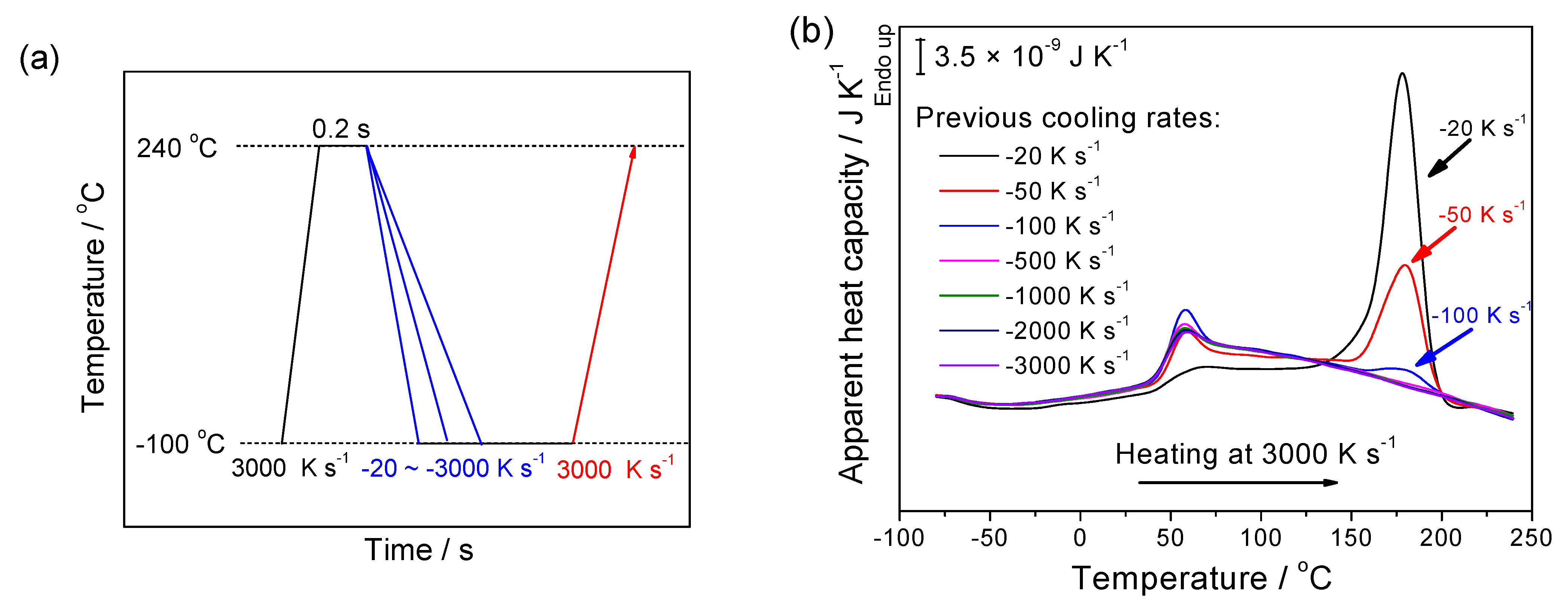
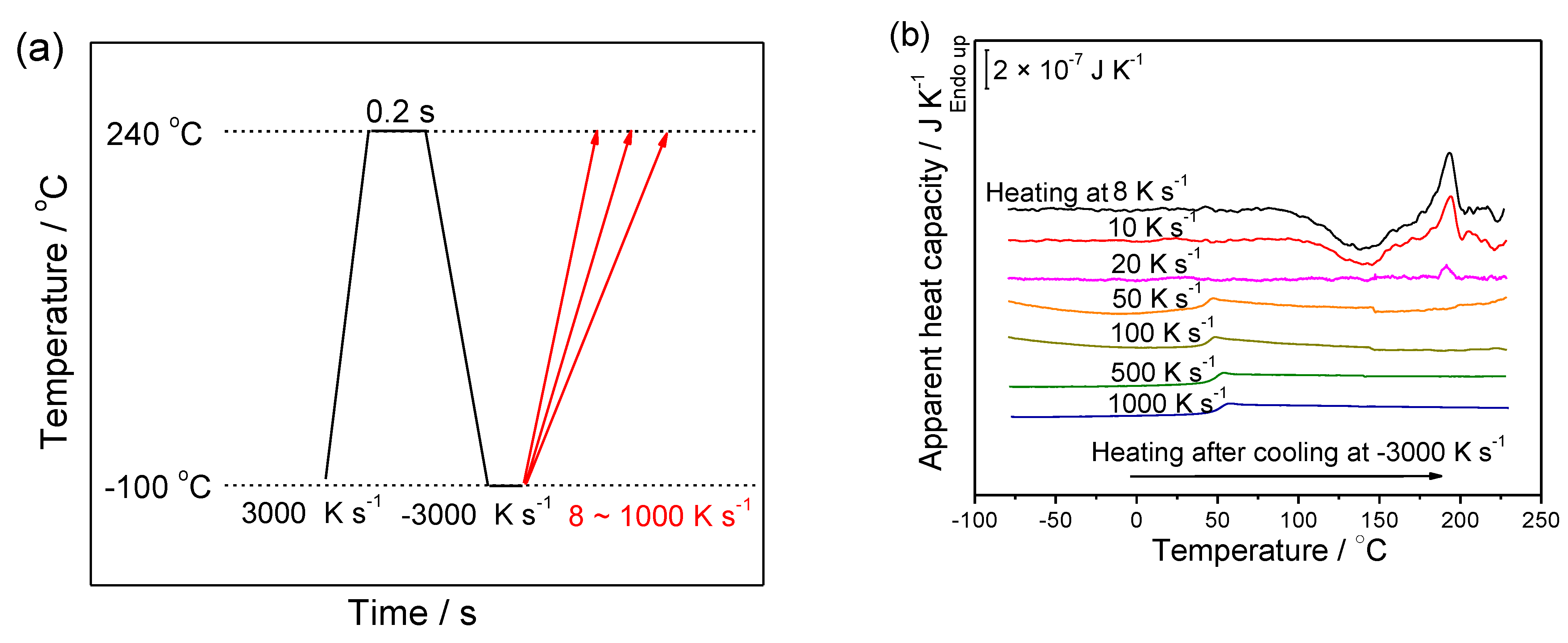
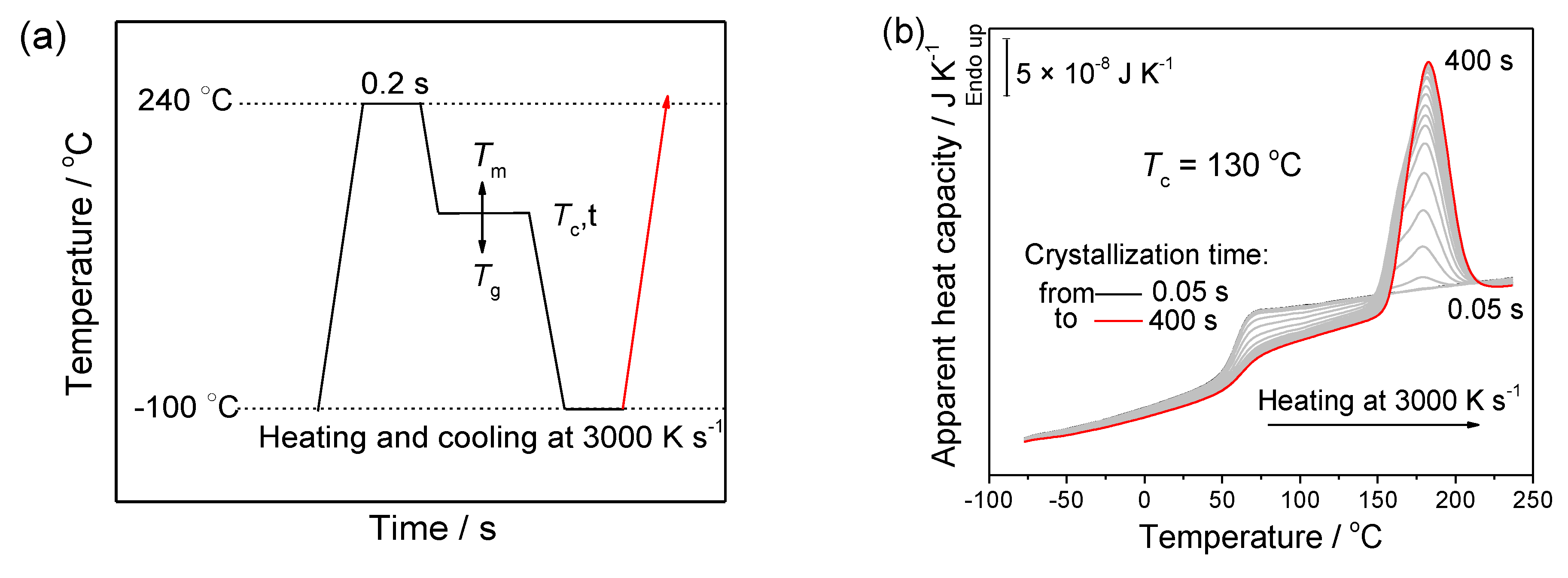
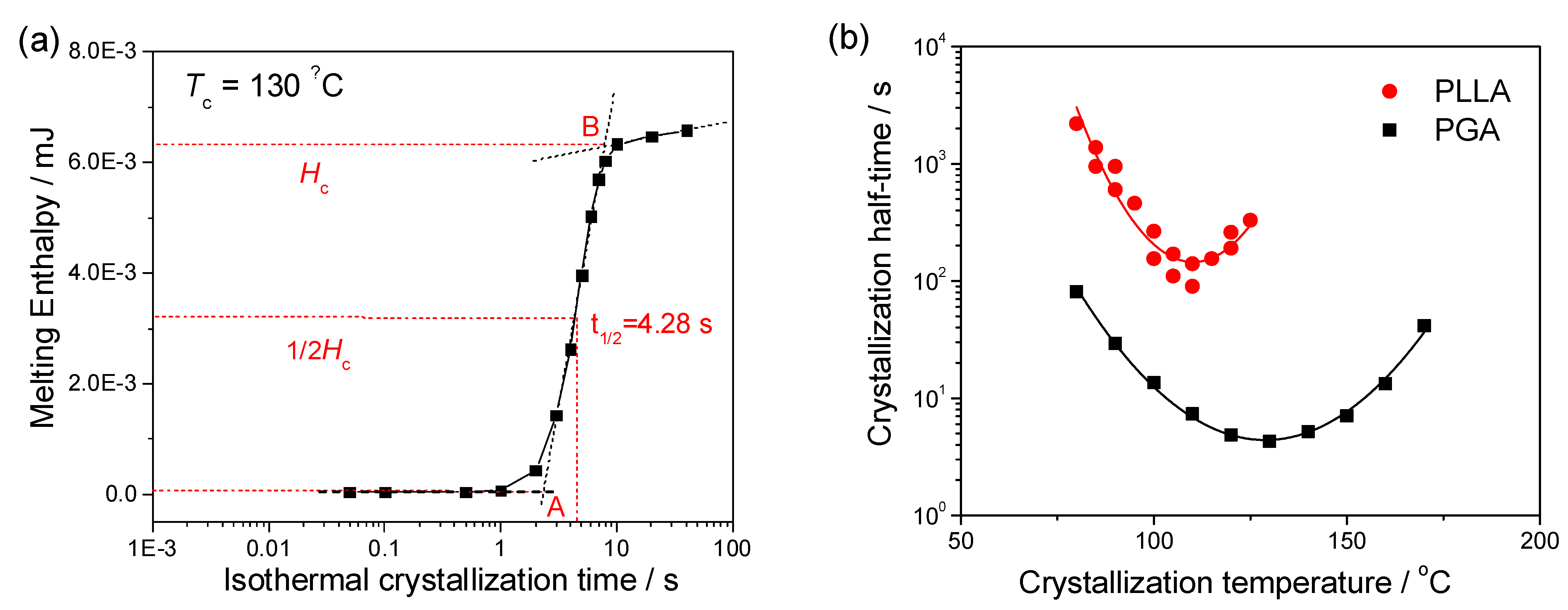
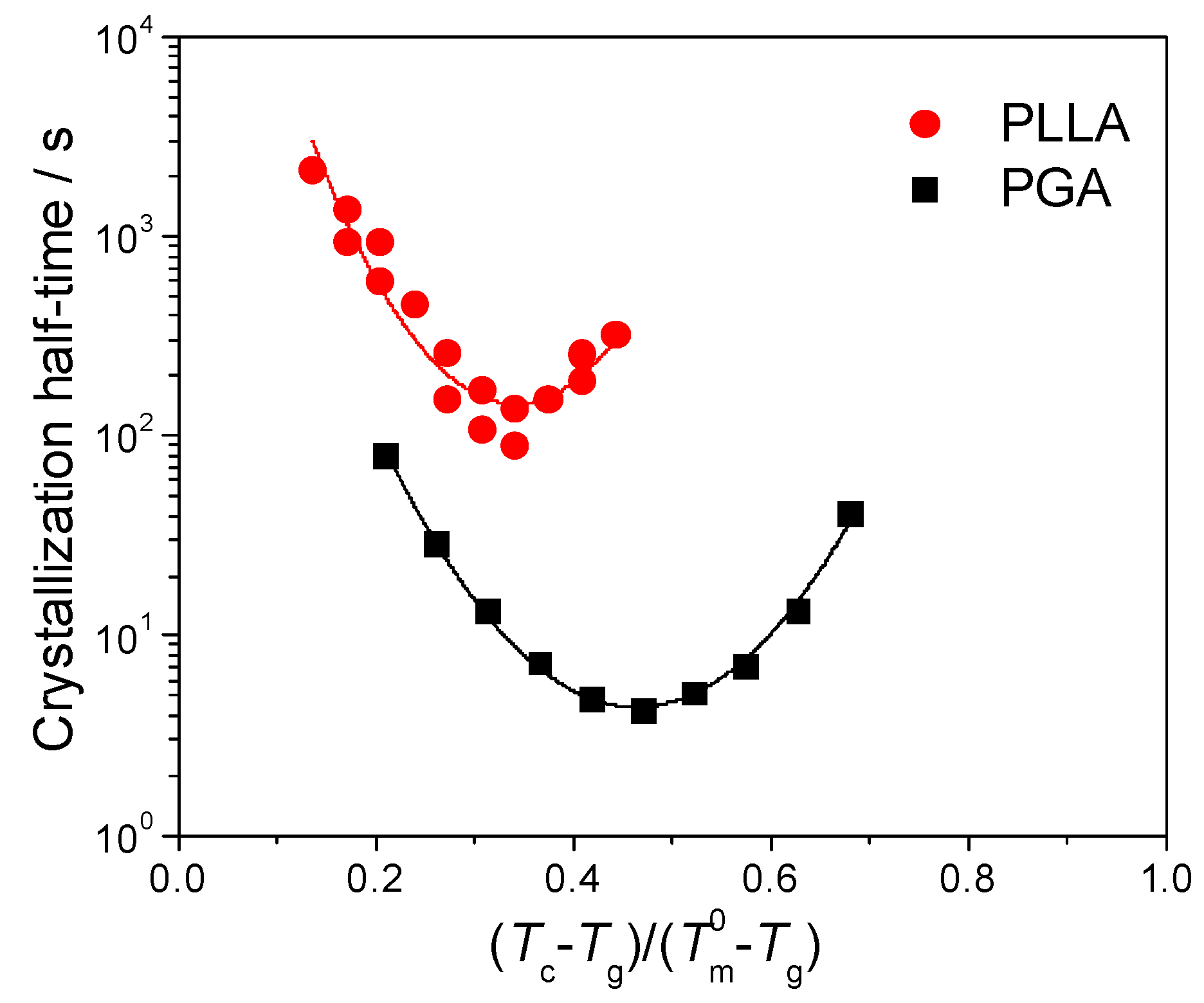
Publisher’s Note: MDPI stays neutral with regard to jurisdictional claims in published maps and institutional affiliations. |
© 2021 by the authors. Licensee MDPI, Basel, Switzerland. This article is an open access article distributed under the terms and conditions of the Creative Commons Attribution (CC BY) license (http://creativecommons.org/licenses/by/4.0/).
Share and Cite
Chen, Y.; Xie, K.; He, Y.; Hu, W. Fast-Scanning Chip-Calorimetry Measurement of Crystallization Kinetics of Poly(Glycolic Acid). Polymers 2021, 13, 891. https://doi.org/10.3390/polym13060891
Chen Y, Xie K, He Y, Hu W. Fast-Scanning Chip-Calorimetry Measurement of Crystallization Kinetics of Poly(Glycolic Acid). Polymers. 2021; 13(6):891. https://doi.org/10.3390/polym13060891
Chicago/Turabian StyleChen, Yongxuan, Kefeng Xie, Yucheng He, and Wenbing Hu. 2021. "Fast-Scanning Chip-Calorimetry Measurement of Crystallization Kinetics of Poly(Glycolic Acid)" Polymers 13, no. 6: 891. https://doi.org/10.3390/polym13060891
APA StyleChen, Y., Xie, K., He, Y., & Hu, W. (2021). Fast-Scanning Chip-Calorimetry Measurement of Crystallization Kinetics of Poly(Glycolic Acid). Polymers, 13(6), 891. https://doi.org/10.3390/polym13060891





